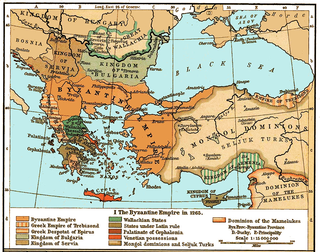Related Research Articles

William of Villehardouin was the fourth prince of Achaea in Frankish Greece, from 1246 to 1278. The younger son of Prince Geoffrey I, he held the Barony of Kalamata in fief during the reign of his elder brother Geoffrey II. William ruled Achaea as regent for his brother during Geoffrey's military campaigns against the Greeks of Nicaea, who were the principal enemies of his overlord, the Latin Emperor of Constantinople Baldwin II. William succeeded his childless brother in the summer of 1246. Conflicts between Nicaea and Epirus enabled him to complete the conquest of the Morea in about three years. He captured Monemvasia and built three new fortresses, forcing two previously autonomous tribes, the Tzakones and Melingoi, into submission. He participated in the unsuccessful Egyptian crusade of Louis IX of France, who rewarded him with the right to issue currency in the style of French royal coins.

Martino Zaccaria was the Lord of Chios from 1314 to 1329, ruler of several other Aegean islands, and baron of Veligosti–Damala and Chalandritsa in the Principality of Achaea. He distinguished himself in the fight against Turkish corsairs in the Aegean Sea, and received the title of "King and Despot of Asia Minor" from the titular Latin Emperor, Philip II. He was deposed from his rule of Chios by a Byzantine expedition in 1329, and imprisoned in Constantinople until 1337. Martino then returned to Italy, where he was named the Genoese ambassador to the Holy See. In 1343 he was named commander of the Papal squadron in the Smyrniote crusade against Umur Bey, ruler of the Emirate of Aydin, and participated in the storming of Smyrna in October 1344. He was killed, along with several other of the crusade's leaders, in a Turkish attack on 17 January 1345.

The War of the Euboeote Succession was fought in 1256–1258 between the Prince of Achaea, William of Villehardouin, and a broad coalition of other rulers from throughout Frankish Greece who felt threatened by William's aspirations. The war was sparked by Villehardouin's intervention in a succession dispute over the northern third of the island of Euboea, which was resisted by the local Lombard barons with the aid of the Republic of Venice. The Lord of Athens and Thebes, Guy I de la Roche, also entered the war against William, along with other barons of Central Greece. Their defeat at the Battle of Karydi in May/June 1258 effectively brought the war to an end in an Achaean victory, although a definite peace treaty was not concluded until 1262.
Nicholas I Sanudo was the fifth Duke of the Archipelago from 1323 to his death. He was the son and successor of William I of the House of Sanudo.

The Triarchy of Negroponte was a crusader state established on the island of Euboea after the partition of the Byzantine Empire following the Fourth Crusade. Partitioned into three baronies run by a few interrelated Lombard families, the island soon fell under the influence of the Republic of Venice. From circa 1390, the island became a regular Venetian colony as the Realm of Negroponte.
Guglielmo II da Verona was a Lombard noble from the triarchy of Negroponte (Euboea), considered by earlier historians as a triarch and a marshal of the principality of Achaea in Frankish Greece.
George I Ghisi was a Latin feudal lord in medieval Greece.

The Barony of Vostitsa was a medieval Frankish fiefdom of the Principality of Achaea, located in the northern coast of the Peloponnese peninsula in Greece, centred on the town of Vostitsa.

The Barony of Arcadia was a medieval Frankish fiefdom of the Principality of Achaea, located on the western coast of the Peloponnese peninsula in Greece, and centred on the town of Arcadia, ancient and modern Kyparissia.

The Barony of Chalandritsa was a medieval Frankish fiefdom of the Principality of Achaea, located in the northern Peloponnese peninsula in Greece, and centred on the town of Chalandritsa south of Patras.
Bartholomew II Ghisi was a Latin feudal lord in medieval Greece, lord of Tinos and Mykonos, Triarch of Negroponte and Grand Constable of the Principality of Achaea.

The Barony of Veligosti or Veligosti–Damala was a medieval Frankish fiefdom of the Principality of Achaea, originally centred on Veligosti in southern Arcadia, but also came to include the area of Damala in the Argolid when it came under a cadet branch of the de la Roche family in the 1250s. After Veligosti was lost to the Byzantines towards 1300, the name was retained even though the barony was reduced to Damala.
Andronikos Asen Zaccaria or Asanes Zaccaria was a Genoese lord of the Principality of Achaea in southern Greece.
Nicholas le Maure was a French knight of the Principality of Achaea, lord of Saint-Sauveur, who served as the Principality's bailli on behalf of the Angevins of Naples between 1314 and 1315/6.
The First Parliament of Ravennika was convened in May 1209 by Latin Emperor Henry of Flanders in the town of Ravennika in Central Greece in an attempt to resolve the rebellion of the Lombard barons of the Kingdom of Thessalonica.
The dalle Carceri were a noble family of Verona and Frankish Negroponte from the 12th to the 14th century.

The Battle of Saint George took place on 9 September 1320 between the Latin Principality of Achaea and the forces of the Byzantine governor of Mystras, at the fortress of Saint George in Skorta in Arcadia. As a result of the battle, Arcadia, the heartland of the Morea, came firmly under Byzantine control.
Erard III Le Maure was Baron of Arcadia and Marshal of the Principality of Achaea in the mid-14th century.
Erard I of Aulnay was lord of one half of the Barony of Arcadia in the Principality of Achaea.
Vilain II of Aulnay was Baron of Arcadia in the Principality of Achaea in the early 14th century.